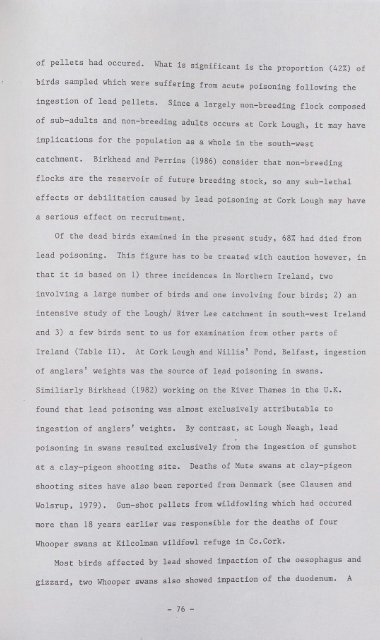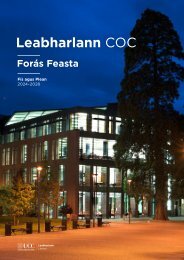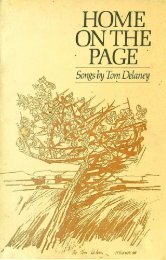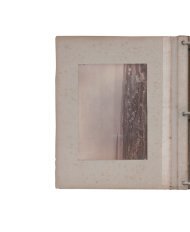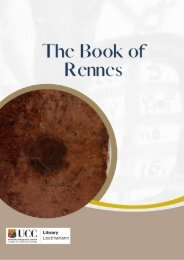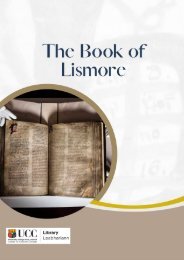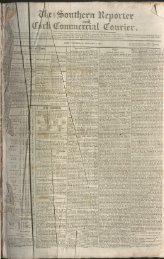Lead Toxicity in Mute Swans
LEAD TOXICITY IN MUTE SWANS Cygnus olor (Gmelin). By JOHN O'HALLORAN A thesis submitted to the National University of Ireland in candidature for the degree of Doctor of Philosophy September 1987
LEAD TOXICITY IN MUTE SWANS
Cygnus olor (Gmelin).
By
JOHN O'HALLORAN
A thesis submitted to the National University of Ireland
in candidature for the degree of Doctor of Philosophy
September 1987
Create successful ePaper yourself
Turn your PDF publications into a flip-book with our unique Google optimized e-Paper software.
of pellets had occured.<br />
What is significant is the proportion (42%) of<br />
birds sampled which were suffer<strong>in</strong>g from acute poison<strong>in</strong>g follow<strong>in</strong>g the<br />
<strong>in</strong>gestion of lead pellets. S<strong>in</strong>ce a largely non-breed<strong>in</strong>g flock composed<br />
of sub-adults and non-breed<strong>in</strong>g adults occurs at Cork Lough, it may have<br />
implications for the population as a whole <strong>in</strong> the south-west<br />
catchment.<br />
Birkhead and Perr<strong>in</strong>s (1986) consider that non-breed<strong>in</strong>g<br />
flocks are the reservoir of future breed<strong>in</strong>g stock, so any sub-lethal<br />
effects or debilitation caused by lead poison<strong>in</strong>g at Cork Lough may have<br />
a serious effect on recruitment.<br />
Of the dead birds exam<strong>in</strong>ed <strong>in</strong> the present study, 68% had died from<br />
lead poison<strong>in</strong>g.<br />
This figure has to be treated with caution however, <strong>in</strong><br />
that it is based on 1) three <strong>in</strong>cidences <strong>in</strong> Northern Ireland, two<br />
<strong>in</strong>volv<strong>in</strong>g a large number of birds and one <strong>in</strong>volv<strong>in</strong>g four birds; 2) an<br />
<strong>in</strong>tensive study of the Lough/ River Lee catchment <strong>in</strong> south-west Ireland<br />
and 3) a few birds sent to us for exam<strong>in</strong>ation from other parts of<br />
Ireland (Table II). At Cork Lough and Willis' Pond, Belfast, <strong>in</strong>gestion<br />
of anglers' weights was the source of le~d<br />
poison<strong>in</strong>g <strong>in</strong> swans.<br />
Similiarly Birkhead (1982) work<strong>in</strong>g on the River Thames <strong>in</strong> the U.K.<br />
found that lead poison<strong>in</strong>g was almost exclusively attributable to<br />
<strong>in</strong>gestion of anglers' weights.<br />
By contrast, at Lough Neagh, lead<br />
poison<strong>in</strong>g <strong>in</strong> swans resulted exclusively from the <strong>in</strong>gestion of gunshot<br />
at a clay-pigeon shoot<strong>in</strong>g site. Deaths of <strong>Mute</strong> swans at clay-pigeon<br />
shoot<strong>in</strong>g sites have also been reported from Denmark (see Clausen and<br />
Wolsrup, 1979).<br />
Gun-shot pellets from wildfowl<strong>in</strong>g which had occured<br />
more than 18 years earlier was responsible for the deaths of four<br />
Whooper swans at Kilcolman wildfowl refuge <strong>in</strong> Co.Cork.<br />
Most hirds affected by lead showed impaction of the oesophagus and<br />
gizzard, two Whooper swans<br />
also Showed impaction of the duodenum.<br />
A<br />
- 76 -


